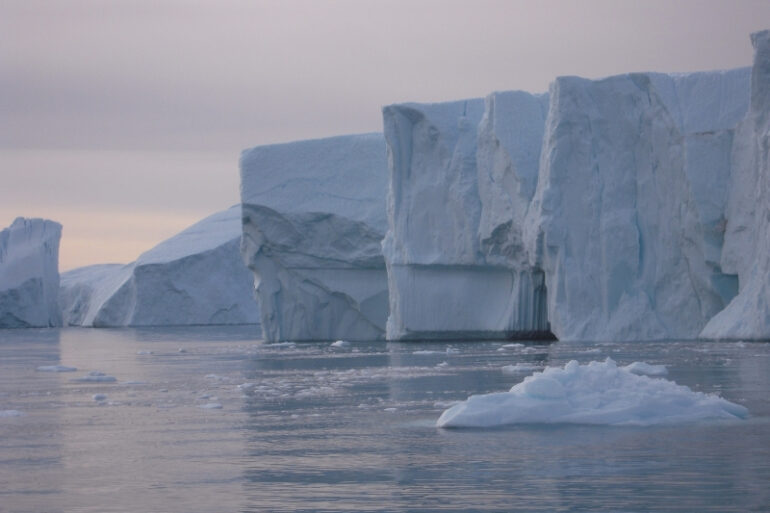Trigger warning: Environmental catastrophe
Ever since the increasing human impact on our planet wasintroduced to us by geologists, we have not had a visual demonstration of it in a wild-life documentary. This changed with the release of Our Planet in 2019, which subtly raisesour awareness of climate change issues.
By Abdelbari Saoufi
»The Anthropocene« was coined by Russian geologist Aleksei Pavlov in 1922 to describe the present »Anthropogenic system (period)«1Simon Lewis/Mark Maslin: Defining the Anthropocene. In: Nature 519, no. 7542 (March 12, 2015), p. 172f.. Since then, environmental issues have been addressed as a political concern, and we have been learning from science and media that the main drivers of our present geological conditions are human activities. These have resulted in deteriorating changes in the earth’s ecosystems, such as biochemical alterations to the composition of the atmosphere, oceans, and soils. Furthermore, these are changes that cause many destructive ecological transformations such as global warming, ocean acidification, expanding oceanic dead zones, and thus habitat loss. These transformations are at the center of the ongoing ecological and political discussions concerned with how to adapt to and lessen their effects2.Cf. T. J. Demos: Against the Anthropocene. Visual Culture and Environment Today. Berlin 2017, p. 8f.
The eight-part series Our Planet3Alastair Fothergill/Keith Scholey/David Attenborough: Our Planet. Silverback Films 2019. Netflix. is a special contribution to these ongoing discussions. A production by the team of the BBC’s Planet Earth and Blue Planet, it was filmed over four years in 50 countries and is narrated by David Attenborough. This documentary uses various landscapes in its episodes to offer its audiences incredible nature scenes. For instance, it provides scenes of miniature worlds such as that of the orchid flowers that have a bucket-like shape; each red bucket is filled with an oily liquid that drips from above. This liquid is needed by male orchid bees as a perfume to impress their females. The bee has to get into the slippery and sticky bucket in order to have it, and when it tries to get out through a little narrow tunnel, the plant has enough time, then, to glue pollen sacs on the bee´s back. This way, the orchid has its pollen taken to another plant and the bee is rewarded with the perfume. The episodes also include a detailed view of a beautiful natural world, such as the touching scenes of fifty different species of manakin birds; each species has its mesmerizing dance routine; for instance, the golden-collared manakin bird clears his dance floor before he performs his dance. And while his lady is checking out every detail of his moves, he performs his final back-flip and twist to conclude his dance. At the same time, towards the end of each episode, the series sheds light on some the consequences of the anthropogenic epoch that can be seen in the gradual extinction of the natural world and its habitats.4Lucy Mangan: Our Planet Review. Attenborough’s First Act as an Eco-Warrior. In: The Guardian (April 5, 2019). https://www.theguardian.com/tv-and-radio/2019/apr/05/our-planet-review-david-attenborough-netflix-eco-warrior-activist-bbc.
This series is exceptional in the way it deals with environmental issues. It offers breathtaking scenes of the vast ice layer of Greenland and its habitats, which are enjoyable to watch for some time while the narrator talks about its role in protecting Earth from overheating. Then it switches to scenes of the place’s current situation, in which the viewer sees how fast the ice layer is melting and how quickly the situation of its habitats is deteriorating. In another instance, the viewer enjoys spectacles of seabirds on different coasts, but at the end of the scenes, the enjoyable moment of viewing is disrupted with the fact that without oceanic currents, the coasts would fall silent and the seabirds would become extinct.
What Makes This Documentary Distinctive?
This series is thoroughly different from other animal or wild-life documentaries in that it subtly puts an emphasis on the threats that all the environments and animals on display are facing. The environmental alert pronounced in this series is quite indirect because most audiences might prefer an entertaining series to an alarming documentary. The mention of eco-problems throughout an entire episode would potentially make them switch off. Therefore, the broadcasters favor a strategy of sharing those incredible scenes and sceneries around the globe, with enough room for sensitization to inspire people to save them.
Our Planet
UK 2019
Narrated by: David Attenborough
The documentary explores different forms of life around the globe that form crucial connections to the balance of Earth systems. Our Planet tells us that every form of life depends on another to survive, and if only one part of the chain is broken, all other forms of life on Earth inevitably follow. The narrator talks about this environmental alarm in a general way. He refers to human activities without holding any third parties accountable, such as the industries that are causing deforestation or those polluting oceanic zones.
David Attenborough simply sheds light on some of the consequences of human activities that are threatening our existence. He does so for about 10 to 15 minutes only in each episode, and every episode ranges from 45 to 50 minutes. This means that the viewer gets absorbed into the beautiful natural world of different habitats for about 30 to 40 minutes. Then, they are awakened by the fact that this balanced natural world they are watching is becoming merely a dream if they do not take action right away to save it.
Scientific Facts and Statistics
After the viewing experience of every episode, the documentary gives statistics and scientific facts that present how fast and to what extent the natural world and its habitats are being impacted. For instance, Attenborough maintains emphatically that what we do in the next 20 years will decide on the future of all habitats on Earth. The Arctic ice is expected to disappear by 2040, and it will have a devastating impact on all of us. This is the strategy that has been employed in this series to make the viewer aware of the anthropogenic system that is threatening the existence of all beings on Earth.
In the same manner, after the viewer has enjoyed incredible scenes of caribou, they are faced with the shocking truth that the herd they are watching is 70 percent smaller than it was 20 years ago. In another scene, the viewer sees 75 million tons of ice falling off an ice shelf in Greenland. Then comes the voice of the narrator to tell us that such losses are now becoming twice as many as they were a decade ago. Later on, after watching beautiful scenes of fossas mating in the Madagascan forests, the narrator informs us that the Madagascan forests have been destroyed and, along with the Borneo jungle, turned into palm oil plantations. With more statistical information placed as a conclusion to every episode, the viewer learns more and becomes well-informed of the anthropogenic danger we are facing.
Mainstream Media Images of Eco-Catastrophes
Some of the questions that have been raised by debaters of this matter are: How can we mobilize politically around a catastrophe’s invisibilities when our culture is dominated by the production of images framed with happy Hollywood endings? And how can we deal with images designed to assure us of the controllability of climate change when they support and advocate for the fact that we are all responsible?5Cf. Demos: Against the Anthropocene, p. 36f. Eventually, it is not the industrial accidents that carry out the most dangerous threat although their effects are absolutely catastrophic. It is the ongoing, uninterrupted, normal work of the fossil fuel economy that should be the greatest concern and the focus of our attention – politically, economically, and ecologically.6Cf. ibid., p. 37f.
Mainstream media images do not contribute much to the responsible use of technology. They rather make a great contribution to an ideology of reassurance designed to appear unbiased.7Cf. ibid., p. 38. For instance, in its 2013 report on the aftermath of the BP oil spill, American commercial media conglomerate CBS announced that BP had made extensive cleanup efforts, and that much of the Gulf has returned to its baseline condition as if the accident had not occurred.8Cf. Jessica Hartogs: Three Years after BP Oil Spill, Active Clean-Up Ends in Three States. In: CBS News (June 10, 2013). http://www.cbsnews.com/news/three-years-after-bp-oil-spill-active-clean-up-ends-in-three-states/. On the history of environmental accidents, from the 1969 Union Oil spill in the Santa Barbara channel to the nuclear meltdown at Three Mile Island in 1979 to the 1989 Exxon Valdez Alaskan oil spill, and on the tendency of corporations and mainstream media to claim that nature will repair itself, see Finish Dunaway: Seeing Green. The Use and Abuse of American Environmental Images. Chicago 2015. Mainstream media take images of such eco-catastrophes and design them for different purposes, including supporting reassurance on the false claim that cleanup efforts following industrial accidents have always been efficient and effective.9Cf. Demos. Against the Anthropocene, p. 33f.
Reality is reshaped and at times reversed by mainstream media images when people of political and economic power are involved. The infamous 2010 BP Deepwater Horizon oil spill eco-catastrophe in the Gulf of Mexico is historically buried by subsequent climate change disasters and industrial accidents. However, the explosion and consequent fire on the oil platform generated numerous horrific images, including those of the blazing plume attended by fireboat response crews extinguishing the fire with water. Other images showed sea animals pathetically concealed in black goo as a result of the release of nearly 260 million gallons of crude into the gulf’s waters. Countless sea habitats have died and more will die from this eco-catastrophe’s consequences for years to come.10Cf. ibid., p. 32.
Responsibility
To shed light on the political power of the criminality occurring in the anthropogenic epoch that we are witnessing, one might consider the case of rogue American entrepreneur Russ George. He released around one hundred tons of iron sulfates into the Pacific Ocean off the west coast of Canada in 2012. His geo-engineering experiment – the largest in the world at the time – was to test the absorption of carbon dioxide by plankton. These microscopic organisms floating on water should, according to his anticipation, sink to the ocean floor. Russ violated many international agreements, including the United Nations Convention on Biological Diversity, and transgressed the trust of the Haida First Nations. The people who approved the project in advance claimed that they had been deceived by George, and that they regretted the approval they had granted him.11Cf. ibid., p. 30f. Demos has raised further thorny questions in this regard:
What system of ethics governs the use of such technology? Who has the right—which individuals, governments, or corporations— to conduct these experiments, and who will pay the costs when accidents occur? And if rights generally derive from nation-states, then what legitimate body can grant permission to geo-engineering projects operating on a global scale?12Ibid., p. 29.
The problem, he maintains, is that only a chosen minority has this exclusive access to those rights. And this reflects a worldwide domination of the growing forms of global economic and sociopolitical inequality. The global citizenry, he stresses, has every right to take part in current discussions of how the world is shaped. Otherwise, the Anthropocene shall have no democratic governance.
Mainstream media images are part of the very technological apparatus of advanced capitalism that has initially created all environmental problems on the planet. Our Planet, however, could only speak of the eco-problems in an indirect way. Producer Alastair Fothergill has voiced frustration that he was not permitted to include more on the matter at the BBC.13Mangan: Our Planet Review. This is because the people who own the fossil fuel and similar industries are very powerful, and they decide on the ideology that dominates mainstream media to shape people’s thoughts and opinions about critical issues.






